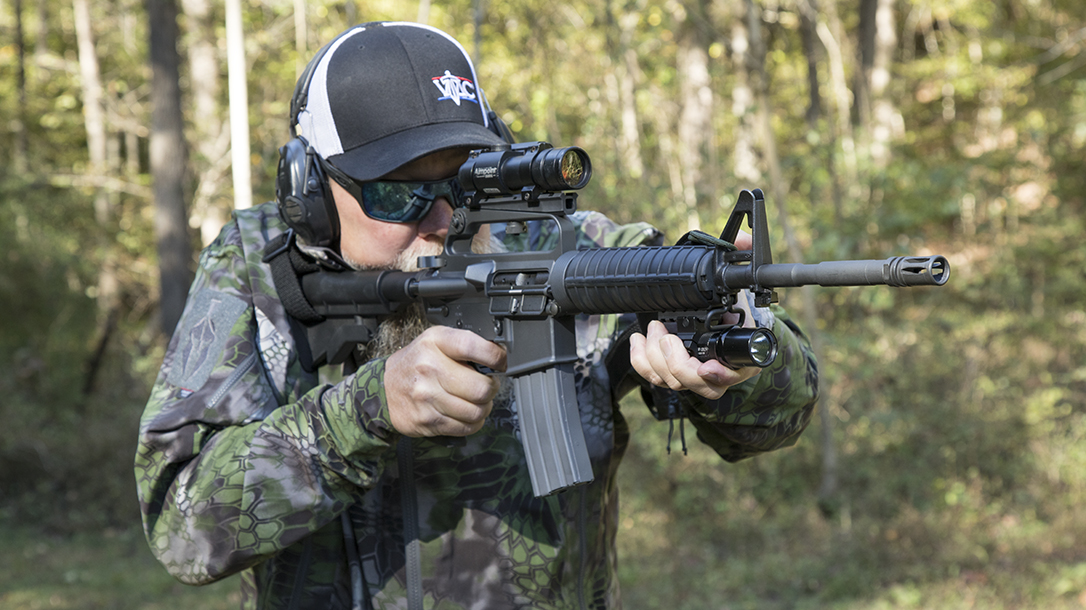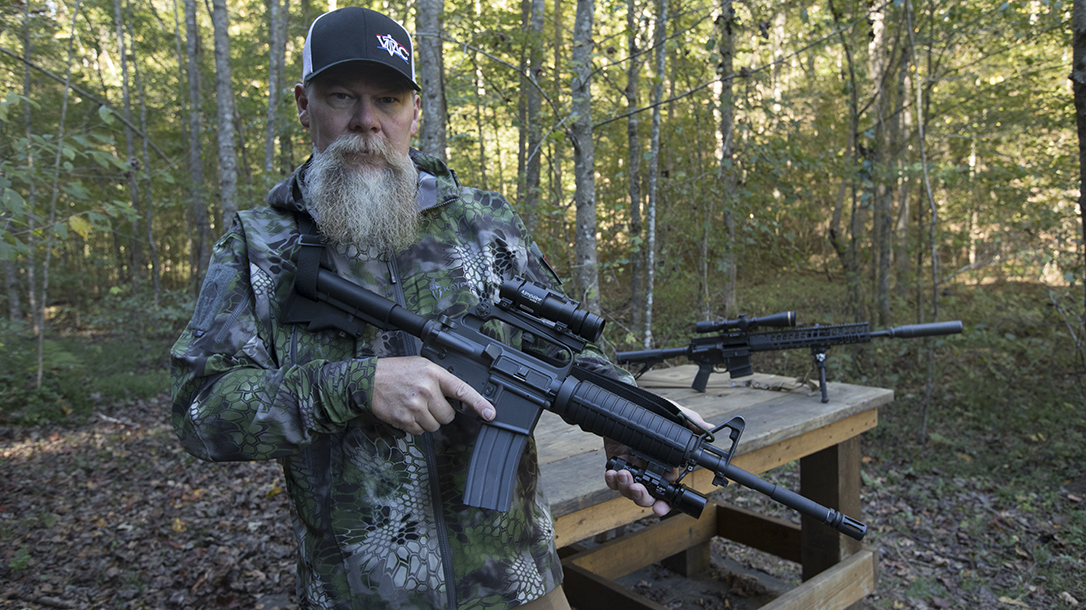It’s hard to believe that it’s been nearly 25 years since the Battle of Mogadishu. That engagement started as a one-hour UN operation to arrest some of the leaders of Mohamed Farrah Aidid’s Habar Gidir clan but became a nearly 40-hour rescue mission after two Black Hawk helicopters were shot down while supporting the mission.
In the process, 19 American servicemen lost their lives. A total of 73 were wounded along with a smaller number of casualties among the allied forces when thousands of Aidid’s hostile supporters attacked the rescuers. Estimates of those killed among Aidid’s people range between 315 and 2,000.
Advertisement — Continue Reading Below
Researching this article, I had the privilege of corresponding with Kyle Lamb. Kyle is a retired 21-year Army veteran who spent the vast majority of his career in special operations.
Kyle, now the president of Viking Tactics (VTAC), was deeply involved in the mission. He is one of the soldiers who endured the very intense fighting around the crash site of the Black Hawk codenamed “Super 61” during the long night of Oct. 3, 1993, as hostile forces laid siege to the American position.
Black Hawk Down
Kyle describes Aidid and his followers as having caused “havoc in Mogadishu, stealing aid supplies and dealing drugs, selling guns and terrorizing the whole territory.” Evidently this had been going on for some time.
Advertisement — Continue Reading Below
On this particular October day, allied forces led by the Americans were after several of Aidid’s lieutenants, who were captured in the raid. In the process, Super 61 was shot down. Kyle’s team was given the task of moving to the crash site, securing the area and treating the wounded.
Just getting to the site proved difficult and one member of the team, Earl Filmore, was killed en route. Once there, they found it impossible to withdraw due to the number of killed and wounded. In addition, Cliff Wolcott, one of the pilots of Super 61, was pinned in the wreckage. The team had to wait for the rescue convoy to arrive with special tools to extract him.
Kyle states that “during this time, we were harassed by Somali gunmen probing our area, so we continued to engage with small arms and made calls for fire from the 160th Special Operations Aviation Regiment AH-6s.”
Advertisement — Continue Reading Below
The Rifleman
The rifleman is and always has been the basic element of the U.S. Army. Riflemen directly engage the enemy, fight the bulk of every battle and hold every position. Therefore, they must to have the best available equipment, and the most important part of their kit is their rifle and its ammunition.
Kyle describes the Mogadishu carbine as being “state of the art” at the time because it had a 14.5-inch barrel, a telescoping stock and an Aimpoint optic on top of the carrying handle.
He further says that the “M4 is the finest battle rifle ever designed” to date, and that many have tried to change the gas system, make piston systems and use special coatings, “but we continue to come back to the M4 as the measuring stick of all these ARs.” He also had praise for the M855 round and said he used it in Mogadishu and “didn’t have issues.”
Advertisement — Continue Reading Below
Troy’s Take
The Battle of Mogadishu was the one of the first intense engagements in what has become a decades-long history of involvement of American forces in the Middle East and Horn of Africa, so it’s fitting that Troy would honor those who fought in it.
I felt privileged to briefly test-fire Troy’s Mogadishu commemorative, the M16A2 SFOD-D Carbine, at the Big 3 East media event and was pleased when I learned that one would be available for testing and evaluation.
Advertisement — Continue Reading Below
Troy M16A2 SFOD-D Features
The Troy M16A2 SFOD-D is a civilian-legal version of the gun carried by those who fought to rescue the survivors of the two Black Hawks that were shot down by RPGs. It has a 14.5-inch barrel like the original, with a A2 flash suppressor permanently affixed to make the gun NFA compliant with an overall length of 16 inches.
In addition, the carbine’s fire control lever only allows the user to select “safe” and “semi.”
For the sake of realism, the receiver is also marked “auto.”
Advertisement — Continue Reading Below
However, the selector cannot be moved to the full-auto position. Also, the gun is internally designed to fire in semi-automatic model only.
Like the original carbine, there is a section of Picatinny rail attached to the forward end of the handguard in the 6 o’clock position. This makes it possible to mount a tactical light like the original carbine had, or if you prefer, a combination light/laser unit.
The carbine also comes with a scope mount that fits the carry handle on the upper receiver and co-witnesses with the gun’s iron sights. The top of the mount has a section of Picatinny rail on which I mounted an Aimpoint 9000SC sight.
Advertisement — Continue Reading Below
The gun is built to current military specifications, with forged, hardcoat anodized upper and lower receivers. M4 feed ramps are built into the 1-in-7-inch-twist barrel, which is designed to stabilize bullets in the popular 75- to 77-grain range.
A True Troy Build
I examined the Mogadishu commemorative at my workbench. Like its other firearms and accessories,Troy built it to the highest-quality standards inside and out.
The single-stage trigger had a 6-pound pull and a clean break. All of the controls functioned as they should. The matte black finish on all of the parts matched. The carbine’s telescoping A2 stock was rock solid, even when fully extended.
Advertisement — Continue Reading Below
All of the parts were well conformed, and there were no tool marks or sharp edges. The only slight imperfection was a minimal misfit between the upper and lower handguard just behind the left side of the front sight.
But, this gun isn’t just a commemorative wall-hanger. It’s a fully capable carbine that can be put into everyday use for recreational shooting and personal defense.
Added Aimpoint
The Aimpoint sights on the original Mogadishu carbines are no longer available. So, as mentioned, I mounted a 7.4-ounce 9000SC. This optic has a 30mm aluminum tube and multi-coated lenses for bright images in low light.
The sight comes with either a 2- or 4-MOA dot. I chose the 2-MOA dot because it would better test the accuracy of the carbine at longer distances.
With the optic mounted, the carbine came in at just under 7 pounds; that makes it light and maneuverable, even when you add the additional weight of a fully loaded magazine, a tactical light and a sling.
Troy M16A2 SFOD-D Carbine Range Test
Unfortunately, fall winds were gusting between 15 and 20 miles per hour when I tested the Troy M16A2 SFOD-D at the Flagler Gun & Archery Club in Florida. This didn’t make measuring the carbine’s accuracy very easy. However, I carefully placed the Aimpoint reticle on the target and slowly squeezed off every shot.
Range Test Ammo
For ammo, I used IMI M855 ball rounds similar to those used in the actual battle and two other military 5.56mm NATO loads: Federal’s 55-grain M193 ball rounds and Black Hills’ civilian version of its 77-grain MK262 Mod 1 rounds. The sight’s dot subtended 2 MOA at 100 yards, so take the accuracy results reported here to be a minimum level of performance.
The accuracy results showed the effect of using a bullet with a higher ballistic coefficient (BC) when shooting in windy conditions, and it reinforced the old advice about shooting your chosen loads in your gun under real-life conditions before putting them into service.
Federal’s 55-grain M193 Ball Rounds
The strong wind pushed the light 55-grain M193 bullets about 4 inches to the right on average. The average group size for three 5-shot groups with this load measured about 8.3 inches.
The heavier 62-grain IMI load, with its higher BC, generally drifted less and impacted about an inch to the right. Its groups were also large, averaging 7.75 inches at 100 yards, clearly showing the effects of gusts.
Black Hills 77-grain MK262 Mod 1 Rounds
The Black Hills 77-grain load was different. It stabilized well and shot to the point of aim. It also bucked the wind well, producing a three-group average of 3.66 inches. The Black Hills load gave excellent performance, given the wind and the Aimpoint’s dot subtending a full 2 MOA at 100 yards. It’s no wonder that this load is known for long-range performance in the deserts and mountains of the Middle East.
I also tested each load’s muzzle velocity and energy, which very good for a short barrel. There was a reduction of about 100 to 150 fps in velocity and a loss of a little over 100 foot-pounds of energy (fpe) from what would normally be expected from a 20-inch rifle barrel. In my book, that’s a fair tradeoff for the carbine’s improved maneuverability.
Drill Time
Lastly, I ran a tactical drill that involved engaging three hostile targets at 25 yards from a standing position that fully exposed me to the gusting wind. Each target was single-tapped and then reengaged with a second shot.
My average time for the drill was 12.6 seconds, with an average score was 42 out of 60 points.
Just for comparison, I ran the drill with a different AR with a variable scope set at 1.5X and a standard non-illuminated crosshair.
The time increased to just more than 17 seconds, giving some idea of just how much faster the Aimpoint sight is at close range. The real value of using a scope doesn’t become apparent until the target is more than 150 yards away, for me at least.
The Troy M16A2 SFOD-D Is a Fitting Tribute
The Troy M16A2 SFOD-D Carbine is a quality product, and that’s how it should be; it honors a group of men who represent the finest in America’s long military history.
It functioned flawlessly and performed very well under difficult conditions when high-BC ammo was used in gusting winds. For those who are interested in owning a piece of history that’s as relevant today as it was 25 years ago, make sure you check out this carbine.
For more information, visit MyServiceRifle.com.
Troy M16A2 SFOD-D Carbine Specs
- Caliber: 5.56mm NATO
- Barrel: 14.5 inches
- OA Length: 30-36.6 inches
- Weight: 6.1 pounds (empty)
- Stock: Collapsible
- Sights: None
- Action: Direct impingement semi-auto
- Finish: Matte black
- Capacity: 30+1
- MSRP: $1,299
This story is from the spring 2018 issue of Ballistic Magazine. Grab your copy at OutdoorGroupStore.com.




























